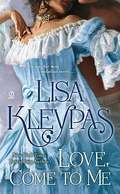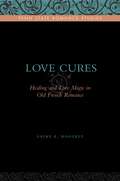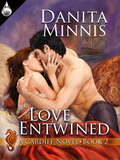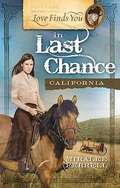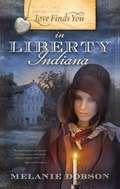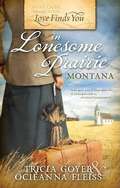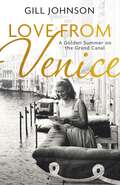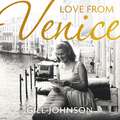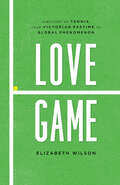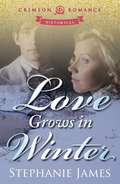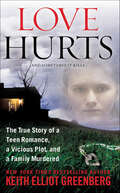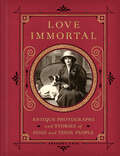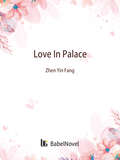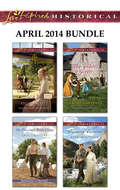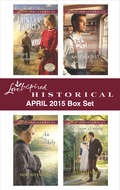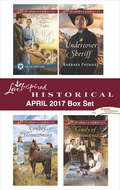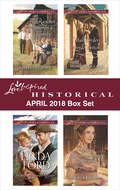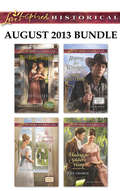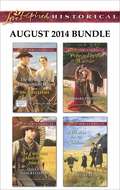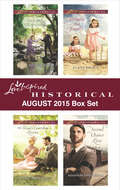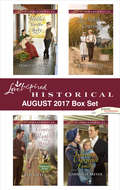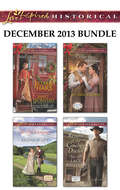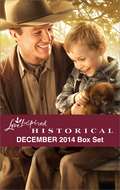- Table View
- List View
Love Come to Me
by Lisa KleypasWhen strong and handsome Heath Rayne pulled Lucinda Caldwell from a winter river, he rescued her from an icy death. But soon he was plunging her into a torrid torrent of passion that this New England beauty had never suspected could claim her. Heath was unlike any other man Lucy had ever known: a dashing, mocking, sensuous Southerner who came as a stranger to Lucy's town-and stayed as he stripped away her last shreds of resistance to the demands of desire and the flaming fulfillment of love...
Love Cures: Healing and Love Magic in Old French Romance (Penn State Romance Studies)
by Laine E. DoggettWhat is love? Popular culture bombards us with notions of the intoxicating capacities of love or of beguiling women who can bewitch or heal—to the point that it is easy to believe that such images are timeless and universal. Not so, argues Laine Doggett in Love Cures. Aspects of love that are expressed in popular music—such as “love is a drug,” “sexual healing,” and “love potion number nine”—trace deep roots to Old French romance of the high Middle Ages. A young woman heals a poisoned knight. A mother prepares a love potion for a daughter who will marry a stranger in a faraway land. How can readers interpret such events? In contrast to scholars who have dismissed these women as fantasy figures or labeled them “witches,” Doggett looks at them in the light of medical and magical practices of the high Middle Ages. Love Cures argues that these practitioners, as represented in romance, have shaped modern notions of love. Love Cures seeks to engage scholars of love, marriage, and magic in disciplines as diverse as literature, history, anthropology, and philosophy.
Love Entwined
by Danita MinnisWhen Roman devises a plan to get Amelie to himself, he sets in motion the final chapter of a love story that began 200 years before. Falling in love again, they find themselves caught in a web of murder and intrigue that spans the ages. From the modern-day corporate world to pre-Revolutionary France and the secrets of St. Clair Manor, one history is laid to rest, another is just beginning in Love Entwined, the sexy, new romance from author Danita Minnis.Amelie Laurent is on her way to the top of the jewelry-designing world with no time for men. Her orderly life is about to come undone when playboy and jewelry tycoon Roman Cardiff steals her away on assignment to a remote English estate. Roman wants Amelie all to himself but St. Clair Manor's resident ghost has been waiting for her much longer than he has.An unseen gunman takes a shot at Roman and he blames a business rival. But Amelie and Roman are to blame, for falling in love 200 years before in a time neither of them remembers.From the heartbreak of pre-Revolutionary France to modern-day corporate wars, Amelie and Roman uncover a history of blood jewels, lust, and demons.When Amelie discovers her inner witch, she learns the real reason she was summoned to St. Clair Manor. Il Dragone will kill to get her back. Amelie will kill if they do.Content Notes: Sweet
Love Finds You in Last Chance, CA (Love Finds You #5)
by Miralee FerrellTwo people trying to make it on their own must work together to save what they both love... It's 1889 and just before Kellie Travers father died, he mortgaged his land in exchange for gold to buy more horses; when no gold is found, Kellie is left with a heavily encumbered ranch and no man to lean on. Not that she wants one. Despite several offers, the feisty redhead has no interest in marriage. Instead, she dons men's clothing and rides the range, determined to make the ranch a success on her own. Justin Phillips arrives in the town of Last Chance, California, with a young son he cannot care for by himself. When he applies for a job on Travers Ranch, Kellie reluctantly accepts his help. Though the young woman can ride, shoot, rope and break young colts, she is irritated to learn that Justin can do everything just a shade better! When disaster threatens Travers Ranch, Kellie and Justin must work together to save someone they both love. Can these two independent people learn to depend on God and each other? Love Finds You is a series of full-length romance novels that give readers a peek into local life across the United States. The novels are uniquely named after actual American towns with quirky, interesting names that inspire romance and are just plain fun! This means that each fictional story draws on the compelling history or unique character of a real place. Our fresh, original love stories will feature everything from romance kindled in small towns, to old loves lost and found on the high plains, to new loves discovered at exciting vacation getaways. Love Finds You promises to deliver the best of romance, travel and escape, all in one inspirational fiction package.
Love Finds You in Liberty, Indiana
by Melanie DobsonIn a divided town during a dangerous era, who can be trusted? Liberty, Indiana, is home to a stop on the Underground Railroad operated by Anna Brent and her father, covert abolitionists who harbor runaway slaves traveling toward freedom. The Brents must be very careful; anyone caught aiding runaways is subject to imprisonment under the Fugitive Slave Act of 1850. So when Anna begins to write columns denouncing slavery in the local newspaper, she must adopt a pen name. Even the newspapers editor, Daniel Stanton, does not know the author's true identity. Daniel takes a risk publishing the columns-- his job, his newspaper, and his very life might be in danger. When Anna's work on the Underground Railroad is threatened, can she turn to Daniel, a man she barely knows, to ensure the safety of the slaves so dear to her? Will she and Daniel be willing to risk everything for their beliefs, including their personal liberty?
Love Finds You in Lonesome Prairie, Montana
by Tricia Goyer Ocieanna FleissJulia Cavanaugh has never left New York City. But in 1890, the young woman must head west to ensure that the orphans under her care are settled into good families. After her final stop in Montana, she plans to head straight back east. But upon arriving in the remote town of Lonesome Prairie, Julia learns to her horror that she is also supposed to be delivered--into the hands of an uncouth miner who carries a bill of purchase for his new bride. She turns to a respected circuit preacher to protect her from a forced marriage but with no return fare and few friends, Julia's options are bleak. What is God's plan for her in the middle of the vast Montana prairie?
Love From Venice: A golden summer on the Grand Canal
by Gill JohnsonIn the summer of 1957, rebelling against her family and anxious to impress an admirer who had moved to Paris, Gill Johnson, aged twenty-five, gave up her comfortable job at the National Gallery in London and travelled to Venice to take up a job teaching English to an aristocratic Italian family. Love from Venice is her vivid evocation of that summer, the last hurrah of the European Grand Tour, when the international jet set lit upon the city for their fun. Drawing on letters that she wrote to David Ross, her admirer and correspondent, and to her parents in London, Johnson describes her life as she flits from palazzo to Lido to palazzo. Absorbed into the social whirl of the super-rich, how do her feelings for her love begin to change?This is a moving and witty memoir of a young woman coming to terms with her own feelings and destiny, and learning about different aspects of love from the people she meets, all set in high-season Venice in a halcyon age.
Love From Venice: A golden summer on the Grand Canal
by Gill JohnsonA charming, funny and glamorous memoir and love-story, about a summer in 1957 in Venice, working for an aristocratic Italian family.In the summer of 1957, anxious to impress an admirer who had moved to Paris, while rebelling against her family, Gill Johnson, aged twenty-five, gave up her comfortable job at the National Gallery in London and travelled to Venice to take up a job teaching English to an aristocratic Italian family. Love from Venice is her vivid evocation of that summer, the last hurrah of the European Grand Tour, when the international jet set lit upon the city for their fun. Johnson describes (including through original letters written to her love in Paris) her life flitting from palazzo to Lido to palazzo, and how her feelings for him grow, while she becomes absorbed into the social whirl of the super-rich. It is a moving and witty memoir of a young woman coming to terms with her own feelings and destiny, and learning about different aspects of love from the people she meets, all set in high-season Venice in a halcyon time. By the end, Johnson discovers if the scabrous excesses of fabulous wealth can divert the course of true love.(P)2024 Hodder & Stoughton Limited
Love From Venice: A golden summer on the Grand Canal
by Gill JohnsonIn the summer of 1957, rebelling against her family and anxious to impress an admirer who had moved to Paris, Gill Johnson, aged twenty-five, gave up her comfortable job at the National Gallery in London and travelled to Venice to take up a job teaching English to an aristocratic Italian family. Love from Venice is her vivid evocation of that summer, the last hurrah of the European Grand Tour, when the international jet set lit upon the city for their fun. Drawing on letters that she wrote to David Ross, her admirer and correspondent, and to her parents in London, Johnson describes her life as she flits from palazzo to Lido to palazzo. Absorbed into the social whirl of the super-rich, how do her feelings for her love begin to change?This is a moving and witty memoir of a young woman coming to terms with her own feelings and destiny, and learning about different aspects of love from the people she meets, all set in high-season Venice in a halcyon age.
Love Game: A History of Tennis, from Victorian Pastime to Global Phenomenon
by Elizabeth WilsonTennis has never been played better than it is today. To watch Rafael Nadal spin a forehand at 4000 rpm, Maria Sharapova arabesque out of a serve, Serena Williams utterly destroy a short ball, or Roger Federer touch a volley into an impossibly angled winner is to watch not only the best players with the best coaching hitting with the best racquets, it is to watch the culmination of an entire history. Love Game is different from most tennis books--it isn't a ghostwritten biography, and it won't teach you how to slice your serve. It's a book about tennis's grand culture, one that unveils the sport's long history as it lives and breathes (or grunts) in the modern game. No one is better equipped to tell this story than novelist and historian Elizabeth Wilson. With a penchant for tennis's inherent drama, she finds its core: a psychological face off between flamboyant personalities navigating the ebbs and flows of fortune in the confines of a 78 x 36-foot box--whether of clay, grass, or DecoTurf. Walking the finely kempt lawns of Victorian England, she shows how tennis's early role as a social pastime that included both men and women--and thus, lots of sexual tension--set it apart from most other sports and their dominant masculine appeal. Even today, when power and endurance are more important than ever, tennis still demands that the body behave gracefully and with finesse. In this way, Wilson shows, tennis has retained the vibrant spectacle of human drama and beauty that have always made it special, not just to sports fans but to popular culture. Telling the stories of all the greats, from the Renshaw brothers to Novak Djokovic, and of all the advances, from wooden racquets to network television schedules, Wilson offers a tennis book like no other, keeping the court square in our sights as history is illuminated around it.
Love Grows in Winter
by Stephanie JamesLord Philip Ravenshaw is through with love. He has spent the better part of his youth as a hopeless romantic, only to be met with heartbreak again and again. Refusing to wallow in self-pity this time, Lord Philip decides to move deep into the Dorset countryside to breed horses in business with a local tradesman.<P><P> When Miss Olivia Winter learns that her father’s new business partner is a lord from London, she is less than thrilled. Her one and only disastrous season in London has left her with the bitter opinion that aristocrats are the most unpleasant sort of people one could ever have the misfortune to meet. For the sake of her father’s business, Olivia decides to pack away her hatred of nobility and greet Lord Philip with as much grace as she can muster.<P> But once Lord Philip mistakes Olivia’s fumbled attempts at hospitality as shameless flirting, and accuses her of social climbing, tempers begin to flare—until one day, their temper turns to passion. Though he tries to fight it, Philip’s love for Olivia begins to grow, but Olivia has her doubts, especially when a jealous debutant threatens to ruin Olivia’s reputation and her chances with Philip... forever.
Love Held Captive
by Shelley Shepard GrayAfter the War Between the States, a Confederate officer longs to heal the heart of a beautiful woman—but first he’ll have to right the wrongs that were done to her.Major Ethan Kelly has never been able to absolve himself of the guilt he feels for raiding a woman’s home shortly before he was taken prisoner during the Civil War. He is struggling to get through each day until he once again crosses paths with Lizbeth Barclay—the very woman he is trying to forget.Life after the war is not much different for former Captain Devin Monroe until he meets Julianne VanFleet. He knows she is the woman he’s been waiting for, but he struggles to come to terms with the sacrifices she made to survive the war.When Ethan and Devin discover that their former colonel, Adam Bushnell, is responsible for both Lizbeth’s and Julianne’s pain, they call on their former fellow soldiers to hunt him down. As the men band together to earn the trust of the women they love, Lizbeth and Julianne seek the justice they deserve in a country longing to heal.
Love Hurts: The True Story of a Teen Romance, a Vicious Plot, and a Family Murdered (St. Martin's True Crime Library)
by Keith Elliot GreenbergFrom a New York Times–bestselling author—a true crime story of a Texas teen&’s 2008 plot to murder her parents for not approving of her boyfriend.&“Readers will be haunted by Greenberg&’s . . . eminently readable true crime tale.&”—Publishers Weekly Alba, Texas. In 2008, Terry Caffey, a home health care aide and aspiring preacher, was asleep in his bedroom when he woke up to a barrage of bullets. His wife, Penny, was killed instantly. With blood pouring from five bullet wounds, among other serious injuries, Terry tried—but failed—to save his two youngest children before crawling out of his burning house. Meanwhile, Terry&’s sixteen-year-old daughter, Erin, was missing… Once Erin was found by local authorities, she claimed she had been kidnapped—but could not remember the details. It wasn&’t until Terry was fully conscious that he could explain what had really happened: He&’d been shot, point-blank, by two young men. One of them he did not know; the other was Charlie James Wilkinson. Charlie was Erin&’s nineteen-year-old boyfriend, forbidden from entering the Caffey home. Until Erin helped Charlie come up with a plan to do away with her disapproving parents once and for all . . . Please note: This ebook edition does not contain photos that appeared in the print edition.
Love Immortal: Antique Photographs and Stories of Dogs and Their People
by Anthony CavoAn artfully designed compendium of 200 antiquarian photographs, all published here for the first time—including daguerrotypes, ambrotypes, tintypes, cartes de visite, and sepia and black-and-white images—culled from the private collection of longtime antiques collector, dealer, and appraiser Anthony Cavo, accompanied by an entertaining mix of historical anecdotes, true stories, excerpts from literature, letters, quotes, and fun facts.“Until one has loved an animal, a part of one’s soul remains unawakened.”—Anatole FranceDogs have been beloved companions since the dawn of humankind. With the advent of photography in the nineteenth century, this love was immortalized for the first time on film. While the clothing and the hairstyles of yesteryear may be very different—and intriguing to the modern eye—in these photos, the evident love between pet and owner is unmistakable, and remains as poignant today as when these images were taken. An avid collector of nineteenth- and early twentieth-century photographs for more than fifty years, Anthony Cavo has amassed an enormous catalog of antique photography, including hundreds of shots of people and their dogs. From this huge array, he has carefully curated 200 extraordinary pictures. These photos were taken from approximately 1840 to 1930 and offer a wide display of both candid and formal studio poses. Cavo arranges his subjects thematically and combines different photographic formats and images from different eras to create visual interest—whether the mix features a particular breed, a selection of images in shadow, or two images identical in pose but taken decades apart or in vastly different locations.In his introduction, Cavo offers a personal overview of this incredible treasury, which provides background on his lifelong experience as a collector and dog lover as well as touches briefly on photography’s birth and various forms in its earliest years. Hehas gathered not only a fascinating array of facts, history, quotes, and anecdotes about dogs which he sprinkles among these charming and fascinating photographs, but enhances the viewing experience for the reader through pointing out details, such as style trends, that help identify when an image was taken Here, too, are delightful anecdotes, from kidnapped pups who escaped and found their way home to devoted dogs who saved their owners’ lives. Cavo offers fun insights into the history of our association with pets, information on a range of breeds, and tips about animal care throughout the ages. Here are touching true stories, quotes from famous historical figures, and a cornucopia of miscellaneous trivia, such as: a dog’s presence in a household helps build immunity from disease in childrenDalmatians are born without their spots the canine is a powerful feng shui symbol of protection and justiceit’s good luck to have a stray follow you homea dog’s nose prints are as unique as a human’s fingerprintsand much moreThe ultimate companion book on humans’ favorite animal companion, Love Immortal is essential for all devoted to dogs, animal lovers, those with an interest in photography , and miscellany buffs.
Love In Palace: Volume 1 (Volume 1 #1)
by ZhenyinfangBai yudie was a simple and lovely girl in Wuyou valley. She never went down the mountain and saved the emperor yeyi who was visited by Weifu. They spent a carefree life in Wuyou valley. However, the reality is always helpless. Night Yi is in a hurry to go back to the palace to deal with the assassination, while Bai yudie cannot leave the valley. Then an accident happened.Bai yudie's master lived in the valley of no worries because of her grudge a few years ago. The sudden disaster forced her to entrust Bai yudie to Ye Yi, so Bai yudie went back to the palace with Ye Yi. But the life in the palace is not suitable for Bai yudie. After a fierce ideological struggle, she finally adapted to the life in the palace.The women in the palace are already covetous for the latter. Can Bai yudie use her kind heart to influence the women in the shadow, and can she change the fate of those women?
Love Inspired Historical April 2014 Bundle
by Laurie Kingery Kerri Mountain Regina Scott Naomi RawlingsLove Inspired Historical brings you four new titles for one great price, available now! This Love Inspired Historical bundle includes The Husband Campaign by Regina Scott, The Preacher's Bride Claim by Laurie Kingery, The Soldier's Secrets by Naomi Rawlings and Wyoming Promises by Kerri Mountain.Look for four new inspirational suspense stories every month from Love Inspired Suspense!
Love Inspired Historical April 2015 Box Set
by Linda Ford Allie Pleiter Dorothy Clark Karen KirstLove Inspired Historical brings you four new titles for one great price, available now! This Love Inspired Historical box set includes Wagon Train Reunion by Linda Ford, An Unlikely Love by Dorothy Clark, From Boss to Bridegroom by Naomi Rawlings and The Doctorâ TMs Undoing by Allie Pleiter.Look for 4 new inspirational suspense stories every month from Love Inspired Historical!
Love Inspired Historical April 2017 Box Set: The Rancher’s Surprise Triplets\Cowboy Homecoming\Undercover Sheriff\Family of Convenience
by Linda Ford Barbara Phinney Louise M. Gouge Victoria W. AustinLove Inspired Historical brings you four new titles! Enjoy these historical romances of adventure and faith.THE RANCHER’S SURPRISE TRIPLETSLone Star Cowboy League: Multiple Blessingsby Linda FordAfter stumbling on triplet orphans abandoned at the county fair, rancher Bo Stillwater’s not sure what to do with them. But when he leaves them in the care of the town doctor’s lovely spinster daughter, Louisa Clark, he finds he can’t stay away—from her or the babies.COWBOY HOMECOMINGFour Stones Ranchby Louise M. GougeWhen cowboy Tolley Northam returns home, he’s determined to finally win his father’s approval. Perhaps a marriage to family friend Laurie Eberly will help him earn it. But when Laurie discovers why he began pursuing her, can he convince her that she holds his heart?UNDERCOVER SHERIFFby Barbara PhinneyAfter a woman, a child and Zane Robinson’s small-town-sheriff twin all go missing, the woman’s friend Rachel Smith has a plan to find them. But for it to work, Zane must pose as his brother and draw out anyone involved in their disappearance.FAMILY OF CONVENIENCEby Victoria W. AustinIn need of a father for her unborn child, mail-order bride Millie Steele agrees to a marriage in name only with single father Adam Beale. But as she grows to love her new children—and falls for their handsome dad—can their convenient family become real?Join HarlequinMyRewards.com to earn FREE books and more. Earn points for all your Harlequin purchases from wherever you shop.
Love Inspired Historical April 2018 Box Set: The Rancher Inherits A Family Montana Lawman Rescuer Mail-order Bride Switch The Unconventional Governess
by Linda Ford Cheryl St. John Dorothy Clark Jessica NelsonLove Inspired Historical brings you four new titles! Enjoy these historical romances of adventure and faith.THE RANCHER INHERITS A FAMILYReturn to Cowboy Creekby Cheryl St. JohnRancher Seth Halloway is stunned when he inherits three sons from a recently deceased friend, but with the help of Marigold Brewster, the lovely new local schoolteacher, he settles into fatherhood. When the boys decide to become matchmakers, though, will he and Marigold find love? MONTANA LAWMAN RESCUERBig Sky Countryby Linda FordWhen Sheriff Jesse Hill rescues Emily Smith and a little boy after a stagecoach robbery, the woman can’t remember anything but her name and that of the child. Now, while searching for the robbers and waiting for Emily’s memory to return, he must resist falling for her.MAIL-ORDER BRIDE SWITCHStand-in Bridesby Dorothy ClarkFleeing a forced betrothal, socialite Virginia Winterman swaps places with Garret Stevenson’s mail-order bride. But Garret needs a wife in-name-only to help in his new hotel…and Virginia hasn’t worked a day in her life. Despite their differences, can she prove to him that she’s his perfect match? THE UNCONVENTIONAL GOVERNESSby Jessica NelsonIf Henrietta Gordon wants to save enough money to reach her dream of becoming a doctor, she needs work—and Dominic, Lord St. Raven, needs a governess for his recently orphaned niece. It’s a temporary arrangement, but the longer she stays, the more tempting it is to make it permanent.Join HarlequinMyRewards.com to earn FREE books and more. Earn points for all your Harlequin purchases from wherever you shop.
Love Inspired Historical August 2013 Bundle
by Lyn Cote Regina Scott Lacy Williams Lily GeorgeLove Inspired Historical brings you four new titles for one great price, available now for a limited time only from August 1 to August 31! Travel back in time and experience powerful and engaging stories of romance, adventure and faith. This Love Inspired Historical bundle includes The Baby Bequest by Lyn Cote, The Courting Campaign by Regina Scott, Roping the Wrangler by Lacy Williams and Healing the Soldier's Heart by Lily George.Look for 4 new inspiring historical stories every month from Love Inspired Historical!
Love Inspired Historical August 2014 Bundle
by Barbara Phinney Lacy Williams Sherri Shackelford Jan DrexlerLove Inspired Historical brings you four new titles for one great price, available now! This Love Inspired Historical bundle includes The Wrangler's Inconvenient Wife by Lacy Williams, The Cattleman Meets His Match by Sherri Shackelford, Protected by the Warrior by Barbara Phinney and A Mother for His Children by Jan Drexler. Look for four new inspirational suspense stories every month from Love Inspired Suspense!
Love Inspired Historical August 2015 Box Set
by Regina Scott Noelle Marchand Shannon Farrington Jo Ann BrownLove Inspired Historical brings you four new titles at a great value, available now! Enjoy these historical romances of adventure and faith.FRONTIER ENGAGEMENT Frontier Bachelorsby Regina ScottAfter schoolteacher Alexandrina Fosgrave is stranded in the wilderness with James Wallin, he offers her his hand in marriage to protect her reputation. Both are afraid to fall in love, but could an engagement of convenience make them reconsider?THE TEXAN'S COURTSHIP LESSONSBachelor List Matchesby Noelle MarchandSince Isabelle Bradley would never marry her sister's former suitor, she offers to help Rhett Granger court himself a wife. As she warms to Rhett, a future together doesn't seem so difficult to imagine--but is she too late?PROMISE OF A FAMILY Matchmaking Babiesby Jo Ann BrownAfter Captain Drake Nesbitt discovers a tiny boat of foundling children adrift at sea, he and Lady Susanna Trelawney begin searching for their families. What they'll discover is an unexpected love that anchors their wayward hearts.SECOND CHANCE LOVEby Shannon FarringtonWhen her fiancé dies suddenly, Elizabeth Martin believes her life is over. It's up to her betrothed's brother, David Wainwright, to help her through the pain...without falling for his brother's almost-bride.
Love Inspired Historical August 2017 Box Set: Unexpected Family
by Lyn Cote Dorothy Clark Jan Drexler Gabrielle MeyerLove Inspired Historical brings you four new titles! Enjoy these historical romances of adventure and faith.WEDDED FOR THE BABYStand-in Bridesby Dorothy ClarkTo fulfill a mail-order bride’s dying wish, Katherine Fleming brings the woman’s baby to the man who promised to raise him. And when she learns Trace Warren needs to marry to keep his business, Katherine agrees to become his wife—temporarily—for the baby’s sake.FRONTIER WANT AD BRIDEWilderness Bridesby Lyn CoteWhat starts as a marriage of convenience between a mail-order bride and a war-weary army captain grows into something more when Judith Jones’s compassion and faith—and two orphaned children—bring solace to Asa Brant’s heart.AN AMISH COURTSHIPAmish Country Bridesby Jan DrexlerSamuel Lapp is content in his estrangement from his Amish community—until Mary Hochstetter moves in next door to take care of her elderly aunt, whom he often helps with chores. As he and Mary grow close, can Samuel face his painful past and find the peace he needs to build a home with her?INHERITED: UNEXPECTED FAMILYLittle Falls Legacyby Gabrielle MeyerAs sole owner of his hotel, Jude Allen is free to run it however he chooses—until his late business partner’s daughter, Elizabeth Bell, arrives to claim the hotel as her inheritance. As he and Elizabeth find a way to work together, can their professional relationship turn into love?Join HarlequinMyRewards.com to earn FREE books and more. Earn points for all your Harlequin purchases from wherever you shop.
Love Inspired Historical December 2013 Bundle
by Jillian Hart Regina Scott Lacy Williams Jo Ann BrownLove Inspired Suspense brings you four new titles for one great price, available now! Enjoy these contemporary heart-pounding tales of suspense, romance, hope and faith. This Love Inspired Suspense bundle includes Mail-Order Mistletoe Brides by Jillian Hart and Janet Tronstad, The Wife Campaign by Regina Scott, A Hero for Christmas by Jo Ann Brown and Return of the Cowboy Doctor by Lacy Williams.Look for four new inspirational suspense stories every month from Love Inspired Suspense!
Love Inspired Historical December 2014 Box Set
by Linda Ford Dorothy Clark Lacy Williams Angel MooreLove Inspired Historical brings you four new titles for one great price, available now! This Love Inspired Historical bundle includes Big Sky Daddy by Linda Ford, A Season of the Heart by Dorothy Clark, A Cowboy for Christmas by Lacy Williams and Conveniently Wed by Angel Moore.Look for four new inspirational suspense stories every month from Love Inspired Historical!
